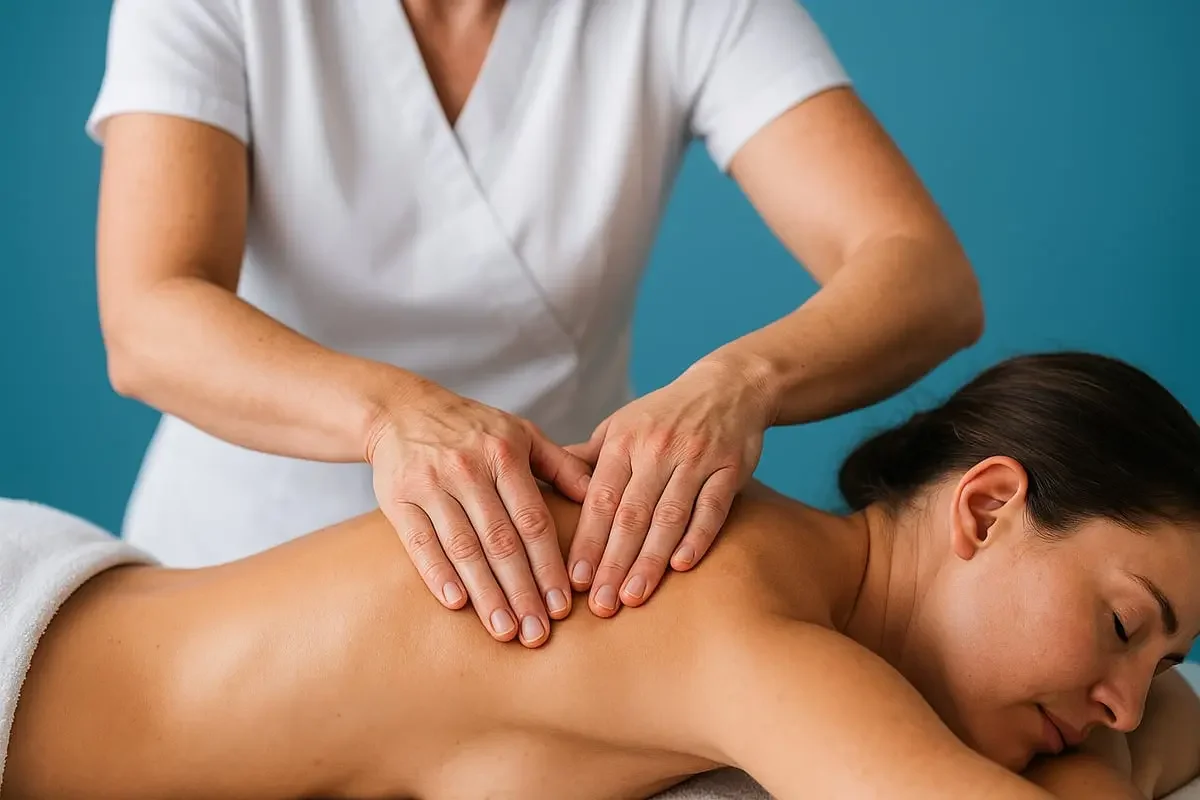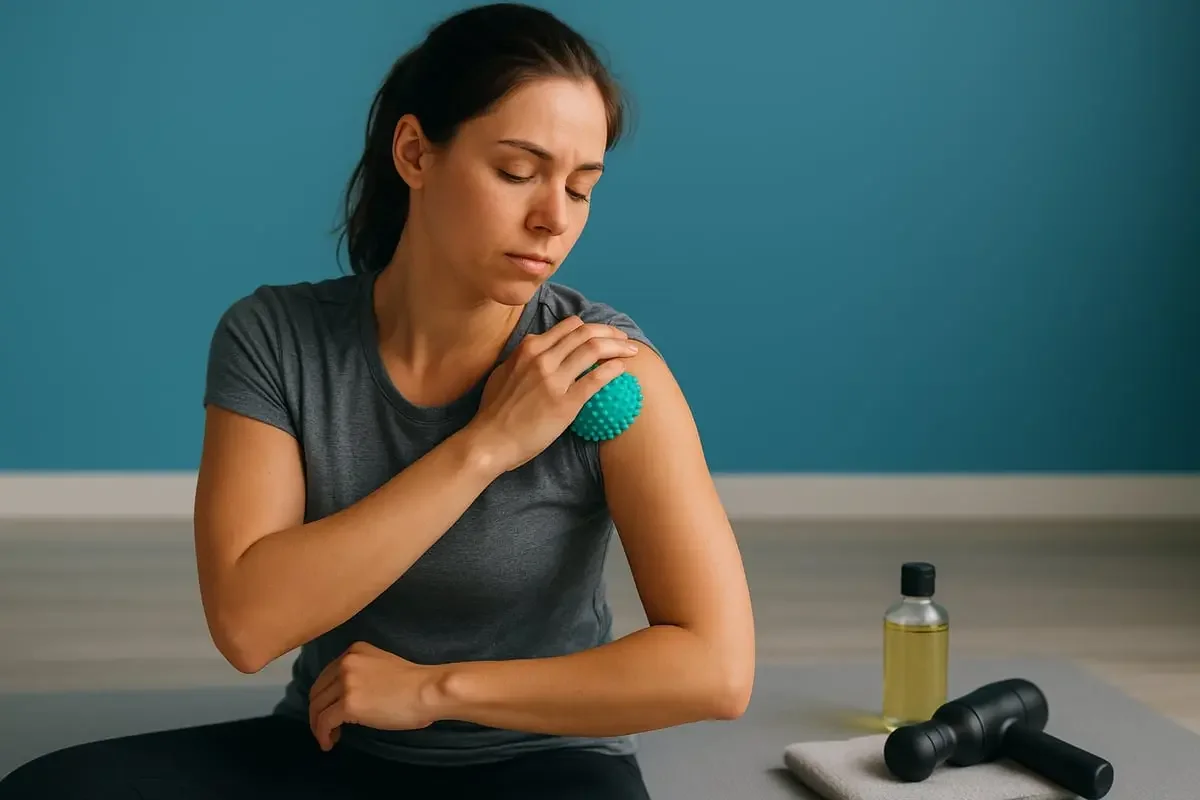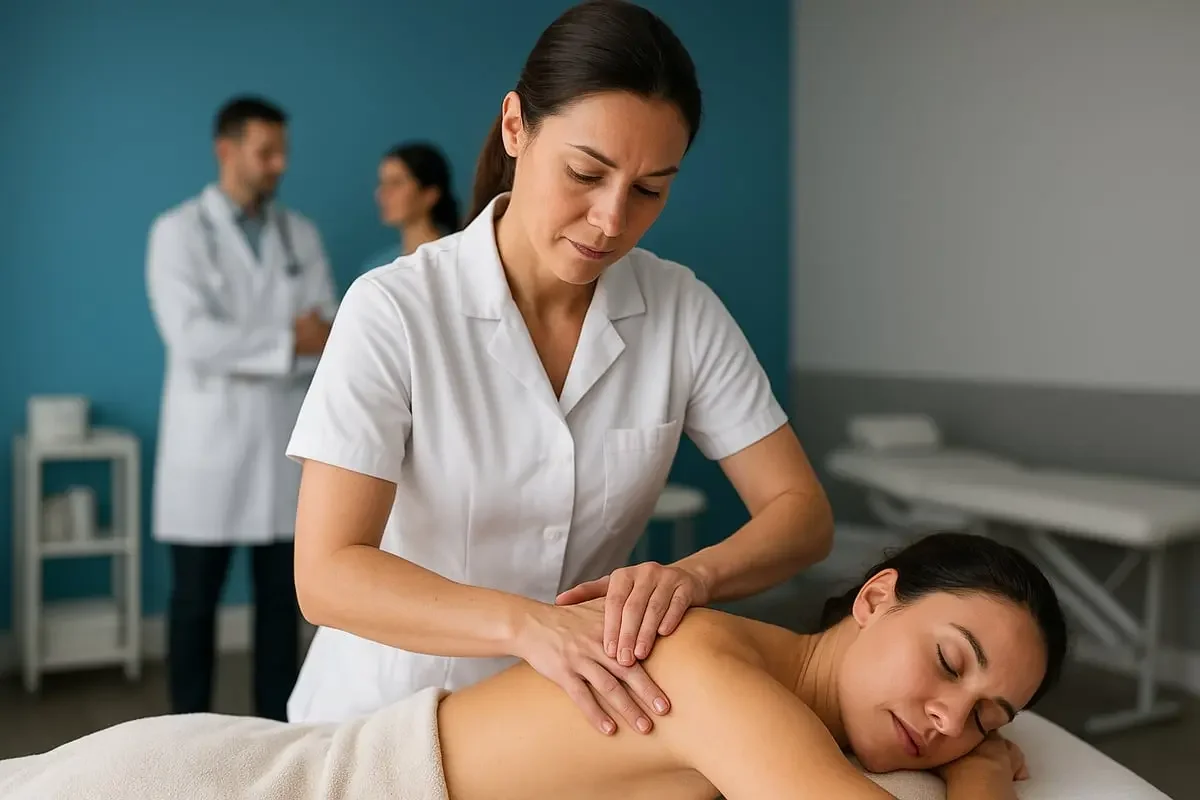Massage Shoulder Pain Guide: North Vancouver Expert Tips for Relief
Shoulder pain is on the rise, affecting millions worldwide and driving more people to seek effective solutions. If you are searching for expert-backed relief, this guide to massage shoulder pain offers a comprehensive, up-to-date resource tailored to your needs.
Inside, you will discover the leading causes of shoulder pain, proven massage techniques, easy self-massage strategies, when to seek professional therapy, and practical tips for lasting comfort.
Ready to move freely and feel better? Explore this expert guide and take the first step toward a pain-free shoulder today.
Understanding Shoulder Pain: Causes and Impact
Shoulder pain continues to affect millions worldwide, and the search for effective solutions like massage shoulder pain relief is more crucial than ever. Understanding the origins and real-life implications of this pain is the first step toward lasting recovery.
Common Causes of Shoulder Pain
Shoulder pain can arise from a variety of sources, many of which are linked to everyday activities or long-term habits. Overuse injuries, such as those seen in athletes or individuals with repetitive job tasks, frequently lead to muscle strain and discomfort. Acute injuries, including falls, sudden impacts, or lifting heavy objects incorrectly, are also common triggers.
Rotator cuff tendinitis, bursitis, and even tears are among the most prevalent causes, often resulting in persistent pain that responds well to targeted massage shoulder pain techniques. Arthritis and degenerative changes in the shoulder joint can develop with age, further limiting mobility and increasing discomfort. Frozen shoulder, or adhesive capsulitis, is another significant contributor.
Poor posture, especially for those who spend extended hours at desks, can create muscle imbalances and tension. This, in turn, can lead to referred pain from the neck or upper back. Nerve impingement or injury is yet another cause, sometimes presenting as sharp, radiating pain.
Being aware of these causes is essential for choosing the right approach to relief and prevention.
The Real-World Impact
The effects of persistent shoulder pain reach far beyond just physical discomfort. Reduced mobility can make simple tasks, such as reaching overhead or lifting objects, exceptionally challenging. Many people with ongoing symptoms report sleep disturbances, as pain often intensifies at night.
Athletic performance and workplace productivity can decline significantly, especially when massage shoulder pain is left untreated. The emotional toll should not be underestimated. Frustration, anxiety, and even depression commonly develop as individuals struggle with limitations in their daily routines.
The economic burden is substantial. Lost productivity, medical expenses, and ongoing treatment costs add up quickly. According to global prevalence and incidence of shoulder pain, the widespread nature of this issue highlights the need for expert-backed strategies.
Early intervention is key. Addressing symptoms promptly with approaches like massage shoulder pain therapy can prevent the transition from acute to chronic pain, supporting better long-term outcomes for both physical and mental health.
How Massage Therapy Relieves Shoulder Pain: The Science Explained
Shoulder pain can disrupt every aspect of daily life, but understanding the science behind relief is empowering. When you explore how massage shoulder pain strategies work, you gain insight into why these methods are trusted by professionals and backed by research. Let us break down the mechanisms, types, evidence, and real-world examples that illustrate why massage is a cornerstone of effective shoulder pain management.
Mechanisms of Massage for Pain Relief
Massage shoulder pain relief is rooted in the body’s natural healing processes. When a therapist applies targeted pressure and movement, several important mechanisms are activated:
Increased blood flow: Massage encourages circulation, delivering oxygen and nutrients to injured tissues.
Reduction of muscle tension: Tight muscles relax, easing discomfort and improving movement.
Breaking down scar tissue: Gentle manipulation helps remodel adhesions and scar tissue that restrict mobility.
Release of endorphins: These natural painkillers help reduce pain perception.
Enhanced joint mobility: Improved flexibility and range of motion make daily activities easier.
Each of these effects contributes to a holistic approach, making massage shoulder pain techniques a vital part of both short-term relief and long-term recovery.
Types of Massage for Shoulder Pain
Not all massage techniques are created equal. The most effective massage shoulder pain approach depends on the underlying cause and the individual’s needs. Common types include:
Deep tissue massage: Focuses on deeper muscle layers, ideal for chronic tension and stubborn knots.
Swedish massage: Uses long, gentle strokes to promote relaxation and overall circulation.
Trigger point therapy: Targets specific muscle knots called myofascial trigger points. According to studies, 56 out of 72 people with shoulder pain have trigger points in the infraspinatus muscle. Learn more about trigger point massage therapy and its impact on shoulder pain.
Myofascial release: Stretches and loosens fascia, the connective tissue surrounding muscles, to reduce stiffness.
Sports massage: Designed for athletes, combining techniques to address repetitive strain and enhance performance.
Selecting the right type of massage shoulder pain intervention ensures the best possible results.
Evidence and Expert Insights
The effectiveness of massage shoulder pain therapy is supported by a growing body of scientific research. Clinical trials have shown that regular massage can significantly reduce pain intensity, improve shoulder mobility, and enhance quality of life for those with chronic and acute conditions.
Experts recommend starting with two to three sessions per week for acute issues, then tapering to maintenance sessions as symptoms improve. However, massage is not always appropriate as acute injuries, infections, or unexplained swelling should be evaluated by a healthcare provider before any intervention.
For individuals with persistent pain, integrating massage shoulder pain therapy into a broader rehabilitation plan has been shown to accelerate recovery and minimize recurrence. Consulting with a trained professional ensures safe and effective care tailored to each person’s needs.
Example Scenarios
Consider a desk worker experiencing chronic upper back and massage shoulder pain from poor posture. After several sessions of trigger point therapy, they report improved function, reduced pain, and better sleep quality.
An amateur athlete with a rotator cuff strain benefits from sports massage combined with myofascial release. The tailored approach enables faster healing and a safe return to activity.
In both cases, massage shoulder pain strategies were adapted to the individual, emphasizing assessment, technique selection, and ongoing evaluation. This personalized care is key to sustainable, long-term relief for diverse lifestyles and causes of discomfort.
Step-by-Step Guide: Effective Massage Techniques for Shoulder Pain
Relieving discomfort requires a thoughtful approach. This step-by-step guide outlines how to use massage shoulder pain techniques effectively, whether you are managing tension at home or supporting a loved one. By following these expert-backed strategies, you can address pain, promote healing, and restore mobility.
Preparing for Massage
Before starting any massage shoulder pain protocol, assess your pain level. Pinpoint the affected area and note if movement increases discomfort. If pain is severe, sudden, or associated with swelling, consult a healthcare professional before proceeding.
Create a comfortable environment. Dim lights, maintain a warm room temperature, and use a supportive chair or mat. Choose a neutral-scented oil or lotion to reduce friction and prevent skin irritation.
Gather your tools: massage balls, foam rollers, or vibration devices. If you are unsure about the cause or severity of your massage shoulder pain, seek guidance from a qualified practitioner. Proper preparation ensures safety and maximizes the benefit of each session.
Self-Massage Techniques
Self-massage is an accessible way to relieve massage shoulder pain, especially for those with chronic tension or postural stress. Begin by locating trigger points. Feel for tender, tight knots in the shoulder, upper back, or around the scapula.
Apply gentle effleurage strokes to warm up the area, using flat palms to glide over the skin. Progress to petrissage, kneading muscles in small circles. Use your thumb or knuckles to apply deeper pressure on stubborn spots. For persistent discomfort, try friction motions to break up adhesions.
Massage balls or handheld massagers can help target hard-to-reach muscles. Vibration massage is recommended by experts for additional pain relief. For chronic issues, consider learning more about Deep tissue massage for pain relief, which targets deeper layers and is effective for many experiencing massage shoulder pain.
Always start with light pressure, gradually increasing intensity as tolerated. Finish with gentle stretches to restore range of motion.
Partner-Assisted Massage
A partner can help address massage shoulder pain in areas that are difficult to reach alone. Open communication is vital. Ask for feedback on pressure and comfort throughout the session.
Focus on the upper back, trapezius, and around the shoulder blade. Use broad strokes to relax the muscles, followed by firmer pressure on tight spots. For those with frozen shoulder, gentle mobilization and assisted stretching may enhance flexibility without causing excessive pain.
Partners should avoid direct pressure on bones or inflamed tissue. Working together, you can improve massage shoulder pain outcomes while building trust and understanding.
Tips for Maximizing Results
To get the most from your massage shoulder pain routine, consistency is key. Short daily sessions often yield better results than occasional lengthy massages.
Stay hydrated before and after each session to aid muscle recovery. Enhance your routine by applying heat before massage to relax muscles or ice after to reduce inflammation.
Combine massage shoulder pain techniques with gentle stretching and strengthening exercises. Monitor your body’s response if you notice increased pain, bruising, or swelling, reduce pressure or frequency.
Keep track of what works best for your body. Adjust techniques as needed to maintain progress and prevent setbacks.
Example Routine
A structured routine helps integrate massage shoulder pain strategies into daily life. For office workers, try this five-minute protocol:
Begin with gentle effleurage strokes on the affected shoulder for one minute.
Use a massage ball against the wall, rolling over tight areas for two minutes.
Apply thumb pressure to trigger points for 30 seconds each.
Finish with light stretching and shoulder rolls for the last minute.
Adopting these routines makes massage shoulder pain management practical and sustainable, whether at home or with a partner.
Advanced Strategies: Professional Massage and Multidisciplinary Care
Seeking advanced solutions for massage shoulder pain often requires more than self-care. Not every case responds to home remedies, and some situations demand the expertise of trained professionals. Knowing when to escalate care is crucial for long-term relief and prevention of complications.
When to Seek Professional Help
If shoulder pain becomes chronic, severe, or does not improve after consistent self-care, it is time to consult a professional. Warning signs include persistent pain lasting more than a few weeks, loss of shoulder movement, or pain that worsens with activity. Additional red flags such as swelling, numbness, or suspected dislocation should prompt immediate evaluation.
Certain conditions, like rotator cuff tears, nerve impingement, or suspected infections, require specialized assessment. Early intervention by a registered massage therapist or allied health professional like a chiropractor can prevent further tissue damage and support optimal recovery. For individuals with complex medical histories, an expert can tailor treatment to unique needs, reducing the risk of chronicity.
What to Expect from Professional Therapy
Professional therapy for massage shoulder pain starts with a comprehensive assessment. Therapists evaluate your medical history, pain patterns, and functional limitations to design a personalized care plan. Treatment often integrates several hands-on techniques, such as deep tissue massage, trigger point therapy, myofascial release, and targeted stretching.
Advanced modalities like shockwave therapy or laser therapy may be included if indicated. Education on posture, home exercises, and ergonomic adjustments supports your recovery between sessions. For those unsure how to find a qualified provider, this North Vancouver registered massage therapist resource offers guidance on choosing the right therapist.
Ongoing communication ensures your treatment adapts to changes in symptoms, maximizing the effectiveness of each session.
Benefits of Multidisciplinary Approach
Combining massage shoulder pain therapy with other disciplines accelerates recovery and addresses root causes. A multidisciplinary team may include massage therapists, chiropractors, physiotherapists, and rehabilitation specialists. Each professional contributes unique skills to create a well-rounded plan.
Key benefits of this collaborative approach include:
Faster reduction of pain and inflammation
Improved mobility and function
Lower risk of recurrence through targeted strengthening
Holistic management of posture and lifestyle factors
By sharing information and aligning treatment goals, the team ensures every aspect of your shoulder pain is addressed. This method not only relieves symptoms but also supports long-term health and performance.
Massage Therapy and Rehabilitation at Mountain Health and Performance
Mountain Health and Performance stands out for its expertise in massage shoulder pain management. The clinic’s practitioners have over 35 years of experience in sports injury, musculoskeletal care, and rehabilitation. Patients benefit from direct billing, support for ICBC and WorkSafeBC claims, and a patient-focused philosophy.
Located in North Vancouver, the clinic offers flexible scheduling, modern facilities, and a multidisciplinary team. Each treatment plan is evidence-based and tailored to fit your goals. The team integrates massage therapy, chiropractic care, and individualized exercise programs for comprehensive relief and prevention.
Choosing Mountain Health and Performance means trusting a clinic committed to delivering measurable results in massage shoulder pain recovery. Their holistic, expert-driven approach empowers you to return to daily activities with confidence.
Self-Care and Lifestyle Tips to Prevent Shoulder Pain Recurrence
Preventing shoulder pain recurrence is an ongoing process that blends smart daily habits with evidence-based self-care. As massage shoulder pain cases continue to rise, integrating these strategies not only supports long-term relief but also reduces the risk of persistent issues. Understanding the economic and personal impact of shoulder pain, as highlighted in the Epidemiology of Shoulder Pain, underscores the necessity of proactive prevention.
Daily Habits for Shoulder Health
Consistent daily routines are crucial for minimizing the chance of massage shoulder pain returning. Focus on maintaining an ergonomic workspace. Adjust monitor height so your eyes are level with the top third of the screen, and use a chair that offers solid lumbar and shoulder support.
Take short movement breaks every 30 to 60 minutes. Stand, stretch, and gently roll your shoulders to prevent tightness. If your occupation puts you at higher risk, as detailed in Shoulder pain prevalence by age and occupation, prioritize frequent posture checks.
Add strengthening and stretching exercises for your rotator cuff and upper back. Simple resistance band routines and doorway stretches can be done at home or the office. Before any athletic activity, perform a warm-up, and always cool down with static stretches to protect your shoulders.
Home Remedies and Adjunct Therapies
Incorporating self-care methods at home can further reduce massage shoulder pain recurrence. Apply a warm pack for 10 minutes to relax tight muscles or a cold pack for acute soreness. Alternate these if you experience both swelling and stiffness.
Gentle mobility exercises, such as pendulum swings or wall crawls, help maintain joint flexibility. Use topical analgesics like Medistik or anti-inflammatory creams as advised by a healthcare professional.
Mind-body techniques can complement physical care. Practice deep breathing or mindfulness meditation to decrease tension and enhance your sense of control over discomfort. Consider using a massage ball or vibration device for targeted relief, supporting the benefits of massage shoulder pain management between professional visits.
Recognizing Red Flags
While self-care is effective for many, it is essential to recognize when to seek medical attention for massage shoulder pain. Stop self-treatment immediately if you experience a sudden loss of shoulder movement, severe swelling, intense pain, or numbness radiating down the arm.
Do not ignore symptoms like unexplained fever, redness, or warmth around the joint. These may indicate infection or a more serious underlying problem. If pain persists for more than a week despite diligent self-care, consult a healthcare provider to rule out rotator cuff tears, dislocations, or nerve involvement.
Daily Checklist:
Ergonomic workstation setup
Hourly movement breaks
Stretching/strengthening routine
Monitor for red flag symptoms
Hydration and healthy posture
Adopting these strategies for massage shoulder pain will empower you to maintain shoulder health, reduce recurrence, and support your active lifestyle.
Frequently Asked Questions About Massage for Shoulder Pain
Shoulder pain can be complex, leading many to seek clear answers before starting massage therapy. Below, we address the most common questions people have about massage shoulder pain, offering expert-backed guidance for safe, effective relief and long-term results.
Top Questions Answered
How often should I get a massage for shoulder pain?
For most cases, a massage shoulder pain routine can start with one or two sessions per week. As symptoms improve, many shift to maintenance sessions every two to four weeks. Your therapist can tailor this based on your needs.
Is massage safe for all types of shoulder injuries?
Massage is generally safe for many shoulder conditions, but it is not suitable for acute injuries, infections, or severe swelling. Always consult a healthcare provider before starting massage shoulder pain therapy if you suspect a serious injury.
Can massage help with old or chronic shoulder pain?
Yes, massage can improve mobility and decrease discomfort, even for chronic issues. Techniques like deep tissue, Swedish, or trigger point therapy are often recommended. For a comparison of sports massage vs. deep tissue, see our detailed guide to help you choose the best approach for your situation.
What are the risks or side effects of massage therapy?
Most people experience only minor soreness after a massage shoulder pain session. However, bruising, increased pain, or allergic reactions to oils are possible. If you notice severe discomfort, stop treatment and contact your provider.
How do I find a qualified massage therapist?
Look for licensed professionals with experience in treating shoulder conditions. Ask about credentials, ongoing education, and client testimonials to ensure quality care.
Can I combine massage with other treatments?
Absolutely. Many find the best relief when combining massage shoulder pain therapy with physiotherapy, exercise, or medication as advised by their healthcare provider.
What should I expect during my first massage session?
Your therapist will review your medical history, assess your symptoms, and explain the treatment plan. Sessions are usually tailored to your comfort level and goals.
Expert Tips and Myths Debunked
Myth: Massage alone can cure all shoulder pain.
Fact: While massage shoulder pain therapy is highly effective for many, it should not replace medical evaluation for severe or unexplained symptoms.
Myth: Any type of massage will work for shoulder pain.
Fact: Specific techniques target different issues. Always discuss your symptoms with your therapist to ensure the most effective approach.
Tip: Consistency matters. Regular massage sessions, combined with stretching and strengthening, offer the best long-term results.
Tip: Insurance and direct billing may be available for massage therapy. Ask your provider or clinic about coverage options.
Tip: Keep realistic expectations. Massage shoulder pain treatment is most effective as part of a holistic recovery plan, including posture correction and activity modification.
By staying informed, choosing the right therapist, and following expert recommendations, you can maximize the benefits of massage shoulder pain relief and support your long-term shoulder health.
After exploring the many ways massage therapy can ease shoulder pain and support long-term healing, you might be wondering what your next step is. If you’re ready to experience expert care tailored to your needs, Mountain Health and Performance’s skilled massage therapists are here to help. Their years of experience in sports injury and rehabilitation mean you’ll receive targeted treatment designed for lasting relief and better mobility. Let’s work together to get you back to doing what you love—pain free and confident.
Book with one of our massage therapists today




